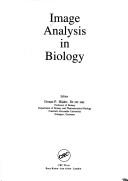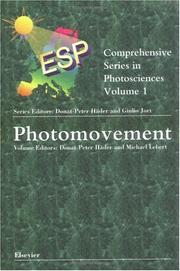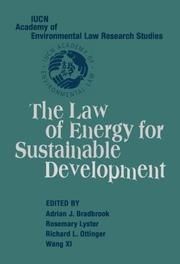| Listing 1 - 9 of 9 |
Sort by
|

ISBN: 0849360331 Year: 1992 Publisher: London CRC Press
Abstract | Keywords | Export | Availability | Bookmark
 Loading...
Loading...Choose an application
- Reference Manager
- EndNote
- RefWorks (Direct export to RefWorks)
Book
ISBN: 0080320287 0080320279 Year: 1987 Publisher: Oxford Pergamon
Abstract | Keywords | Export | Availability | Bookmark
 Loading...
Loading...Choose an application
- Reference Manager
- EndNote
- RefWorks (Direct export to RefWorks)
General biophysics --- Photobiology --- Photobiologie --- 577.34 --- 577.3 --- #WSCH:MODS --- Biology --- Light --- Photochemistry --- Photochemistry of biological systems. Radiation biophysics. Primary processes (physicochemical processes) in photobiology, in radiobiology --- Physical and physicochemical bases of life. Biophysics. Biophysical chemistry in general --- 577.3 Physical and physicochemical bases of life. Biophysics. Biophysical chemistry in general --- 577.34 Photochemistry of biological systems. Radiation biophysics. Primary processes (physicochemical processes) in photobiology, in radiobiology

ISBN: 9780444507068 044450706X 9780080538860 008053886X 9786611119645 1281119644 Year: 2001 Publisher: Amsterdam ; New York : Elsevier,
Abstract | Keywords | Export | Availability | Bookmark
 Loading...
Loading...Choose an application
- Reference Manager
- EndNote
- RefWorks (Direct export to RefWorks)
This volume emphasizes the involvement of all facets of biology in the analysis of environmentally controlled movement responses. This includes biophysics, biochemistry, molecular biology and as an integral part of any approach to a closer understanding, physiology. The initial euphoria about molecular biology as the final solution for any problem has dwindled and the field agrees now that only the combined efforts of all facets of biology will at some day answer the question posed more than hundred years ago: ""How can plants see?"". One conclusion can be drawn from the current knowledge as s
Phototropism in animals. --- Phototropism in plants. --- Phototropism. --- Animals --- Animal orientation --- Light --- Phototropism --- Plants --- Heliotropism --- Irritability --- Orientation (Physiology) --- Photobiology --- Phototaxis --- Tropisms --- Physiological effect --- Photomorphogenesis
Book
Abstract | Keywords | Export | Availability | Bookmark
 Loading...
Loading...Choose an application
- Reference Manager
- EndNote
- RefWorks (Direct export to RefWorks)

ISBN: 0521845254 9780521845250 9780511511387 9781107407718 0511109679 9780511109676 0511109369 9780511109362 9786610422166 6610422168 0521820529 1107136156 1280434694 9786610434695 0511171404 051119711X 0511298498 0511546211 1107407710 1107140951 051117120X 0511082371 051129834X 0511511388 1280422165 0511196903 0511081928 9780511082375 9780511081927 Year: 2005 Publisher: New York s.n.
Abstract | Keywords | Export | Availability | Bookmark
 Loading...
Loading...Choose an application
- Reference Manager
- EndNote
- RefWorks (Direct export to RefWorks)
Unicellular organisms use gravity as an environmental guide to reach and stay in regions optimal for their growth and reproduction. These single cells play a significant role in food webs and these factors together make the effects of gravity on unicellular organisms a fascinating and important subject for scientific study. In addition, they present valuable model systems for studying the mechanisms of gravity perception, a topic of increasing interest in these days of experimentation in space. This book reveals how single cells achieve the same sensoric capacity as multicellular organisms like plants or animals. It reviews the field, discussing the historical background, ecological significance and related physiology of unicellular organisms, as well as various experimental techniques and models with which to study them. Those working on the biology of unicellular organisms, as well as in related areas of gravitational and space science will find this book of value.
Power resources --- Electric utilities --- Sustainable development. --- Energy industries --- Law and legislation. --- Environmental aspects. --- Gravity --- Unicellular organisms. --- Physiological effect. --- Unicellular organisms --- Microorganisms --- Physiological effect --- Gravity. --- Law --- General and Others --- Power resources - Law and legislation. --- Electric utilities - Law and legislation. --- Energy industries - Environmental aspects. --- Development, Sustainable --- Ecologically sustainable development --- Economic development, Sustainable --- Economic sustainability --- ESD (Ecologically sustainable development) --- Smart growth --- Sustainable development --- Sustainable economic development --- Economic development --- Electric power --- Environmental aspects --- Law and legislation
Book
ISBN: 313737801X Year: 1990 Publisher: Stuttgart Thieme
Abstract | Keywords | Export | Availability | Bookmark
 Loading...
Loading...Choose an application
- Reference Manager
- EndNote
- RefWorks (Direct export to RefWorks)
Dissertation
Year: 1973 Publisher: Augsburg Blasaditsch
Abstract | Keywords | Export | Availability | Bookmark
 Loading...
Loading...Choose an application
- Reference Manager
- EndNote
- RefWorks (Direct export to RefWorks)
Book
ISBN: 3319938932 3319938940 Year: 2018 Publisher: Cham : Springer International Publishing : Imprint: Springer,
Abstract | Keywords | Export | Availability | Bookmark
 Loading...
Loading...Choose an application
- Reference Manager
- EndNote
- RefWorks (Direct export to RefWorks)
This book summarizes what is currently known about gravity sensing and response mechanisms in microorganisms, fungi, lower and higher plants; starting from the historical eye-opening experiments from the 19th century up to today’s extremely rapid advancing cellular, molecular and biotechnological research. All forms of life are constantly exposed to gravity and it can be assumed that almost all organisms have developed sensors and respond in one way or the other to the unidirectional acceleration force,this books shows us some of these different ways. The book is written for plant biologists and microbiologists as well as scientists interested in space and gravitational biology.
Gravity --- Physiological effect. --- Cytology. --- Astronautics. --- Microbiology. --- Botany. --- Cell Biology. --- Aerospace Technology and Astronautics. --- Plant Sciences. --- Botanical science --- Phytobiology --- Phytography --- Phytology --- Plant biology --- Plant science --- Biology --- Natural history --- Plants --- Microbial biology --- Microorganisms --- Space sciences --- Aeronautics --- Astrodynamics --- Space flight --- Space vehicles --- Cell biology --- Cellular biology --- Cells --- Cytologists --- Cell biology. --- Aerospace engineering. --- Plant science. --- Aeronautical engineering --- Astronautics --- Engineering --- Floristic botany
Digital
ISBN: 9783319938943 Year: 2018 Publisher: Cham Springer International Publishing
Abstract | Keywords | Export | Availability | Bookmark
 Loading...
Loading...Choose an application
- Reference Manager
- EndNote
- RefWorks (Direct export to RefWorks)
This book summarizes what is currently known about gravity sensing and response mechanisms in microorganisms, fungi, lower and higher plants; starting from the historical eye-opening experiments from the 19th century up to today’s extremely rapid advancing cellular, molecular and biotechnological research. All forms of life are constantly exposed to gravity and it can be assumed that almost all organisms have developed sensors and respond in one way or the other to the unidirectional acceleration force,this books shows us some of these different ways. The book is written for plant biologists and microbiologists as well as scientists interested in space and gravitational biology.
Space research --- Astronomy --- General microbiology --- Histology. Cytology --- Plant physiology. Plant biophysics --- Botany --- systematische plantkunde --- astronauten --- microbiologie --- biotechnologie --- cytologie --- histologie --- botanie --- ruimtevaart --- moleculaire biologie
| Listing 1 - 9 of 9 |
Sort by
|

 Search
Search Feedback
Feedback About UniCat
About UniCat  Help
Help News
News